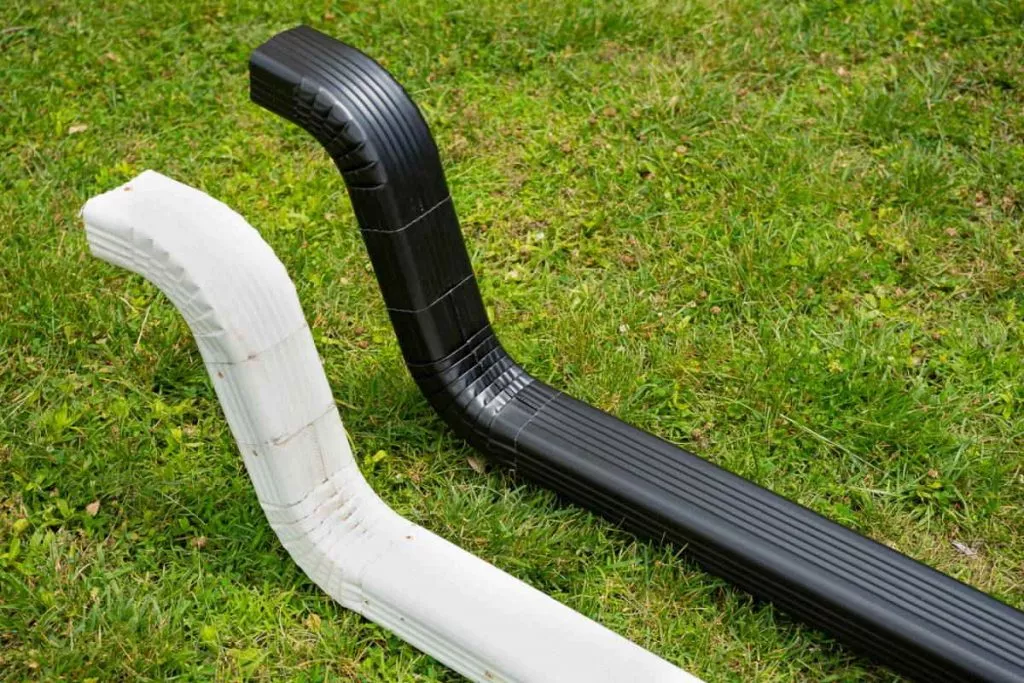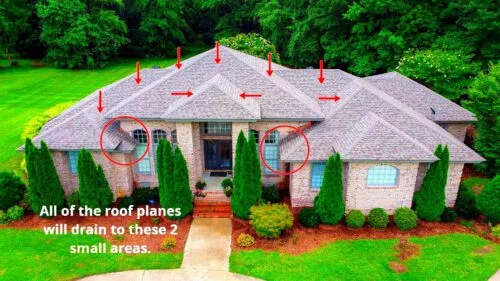What Size of Gutters Do I Need?
 When looking at installing or replacing your gutters, does the size really matter? Well, to answer that simple question, you have to start with a few other questions.
When looking at installing or replacing your gutters, does the size really matter? Well, to answer that simple question, you have to start with a few other questions.
- What is the size of your roof?
- How much water volume are you expecting?
- What is the level of rainfall in your area?
- How many feet of roof eaves are there?
Having the proper gutter size is a key component of home maintenance. Gutters that are too small can spill over both the front and the rear, leading to rot issues on your fascia, and possible water intrusion into your crawl space.
The most common gutter sizes to see on residential homes are 5″ and 6″ gutters, with 5″ gutters being far more common for builders to install. When you see 6″ gutters on a home, it’s most likely that the homeowner upgraded their gutter system.
The most common gutter style (or profile) is the K-Style gutter, which looks like a piece of crown once it is installed. K-Style gutters typically have rectangular downspouts installed with them. The 2nd most common gutter style is the half-round, which typically has round downspouts. For the purposes of this article, we will be focusing on the K-Style gutters and rectangular downspouts.
Before you can establish the proper gutter size, you need to assess the downspouts.
What Size Downspouts Do I Need?
Just as important as the gutter size is the downspout size. Many builders in the Raleigh area use the 2″x3″ downspouts (which have a cross-section size of 6 square inches), due to their lower cost. However, the difference in cost is roughly $0.02 per linear foot. The smaller downspouts are almost always inadequate for handling excessive rain, causing numerous issues. As a result, we at Odyssey Contracting install the 3″x4″ (which have a cross-section size of 12 square inches) downspouts on all of our gutter replacement projects. With the 3″x4″ downspouts having twice the draining capacity of 2″x3″, we can often reduce the number of downspouts needed.
How Many Downspouts Do I need?
The number of downspouts is also a key component for having an efficient gutter system. Unfortunately, the architecture of many homes prevents an adequate number of downspouts from being installed, while maintaining a pleasing appearance. Having too many downspouts can also take away from the beauty of your home, especially on the front.
A general rule-of-thumb for establishing the number of downspouts is to install one downspout for every 20′ – 25′ of gutter. This method isn’t full proof, and is best used on straight gable style roofs, not complex roofs like you see below. Complex roofs require critical thinking to establish your downspout size and needs.
To figure the number of downspouts you’ll need, you need to first establish how many roof planes will drain onto each section of gutters. If many roof planes are draining into a small area (like you see in the photo), you’ll either need extra downspouts or oversized downspouts. In this case, we will be installing 4″x5″ downspouts to accommodate the large amount of roof drainage that will happen here.
Gutter Style Effects Holding Capacity
We also need to determine the style of the gutter you want to be installed. Keep in mind the style of the gutters also has a significant impact on the amount of water the gutter can handle. Typical styles for residential homes are round-shaped and K-style. K-style gutters can accommodate approximately double the amount of water as the round-shaped ones. So if you’re thinking about using half-round gutters, be sure you get the largest size available.
Roof Square Footage Determines Gutter Size & Quantity
The square footage of your roof is likely the most important factor in determining the adequate gutter size. This is because the more footage of roof you have, the greater the volume of rainwater that will land on it and need to drain. A decent rule of thumb to use is “4,000 sq ft or below gets 5″ gutters, more than 4,000 sq ft needs 6″ gutters”.
Don’t make the mistake of using your homes’ square footage, as this does not correlate to the roof square footage. Instead, you’ll need to take the square footage of your home’s footprint, establish the pitch of your roof, and then do a little math. This isn’t an exact calculation, but rather a close approximation. For exact square footage totals, you should consider purchasing an Eagleview report, or contact a roofer to hand measure. Once you’ve established the footprint of your home, and the pitch of the roof, you’ll multiply the footprint square footage by the following:
- 6/12 pitch or below, multiply by 1.15
- 7/12 – 9/12 pitch, multiply by 1.2
- 10/12 – 12/12 pitch, multiply by 1.3
The calculation above is not the only factor you should consider for choosing your gutter size. Just as important as your roof size and the volume of water it will shed is the amount of roof eaves that are on your home. The gutters are installed on the roof eaves, so the more of them you have the more gutters you can install. “Hip-style” roofs typically have 30% – 40% more eaves than that of “Gable-style” roofs. This means that it’s more likely you’ll need larger gutters on a gable roof than a hip roof.
Or just know this, the larger the roof area, the more water is going to be coming down. So, if you have a smaller roof with a lower pitch, the need to upgrade and pay for the larger, 6-Inch, gutter could be a waste of money. For most homes, a 5″ gutter with 3″x4″ downspouts will be adequate.
If you aren’t certain which size to get, contact our office to schedule one of our specialists to help you to determine the proper gutter size. Don’t forget to follow us on social media for our latest deals and specials & events!
Key Items To Consider When Having Gutters Installed:
- Material Thickness (0.032″ AKA Heavy-Duty is best)
- Rivets vs screws (Rivets look better and last longer)
- Spike-and-Ferrule or Gutter Hangers (Gutter hangers are far better)
- Gutter Guards (Debris in the gutters will prevent water drainage)
